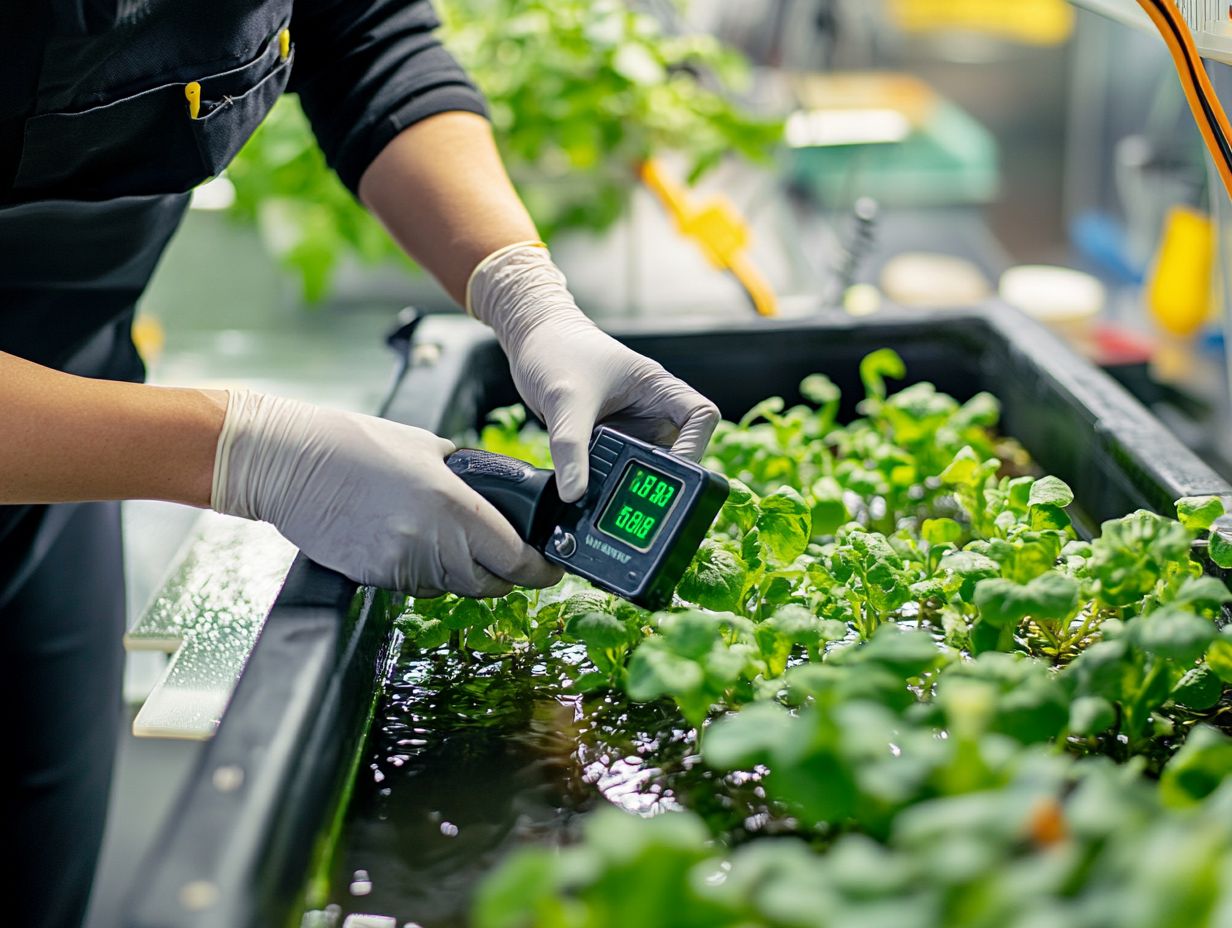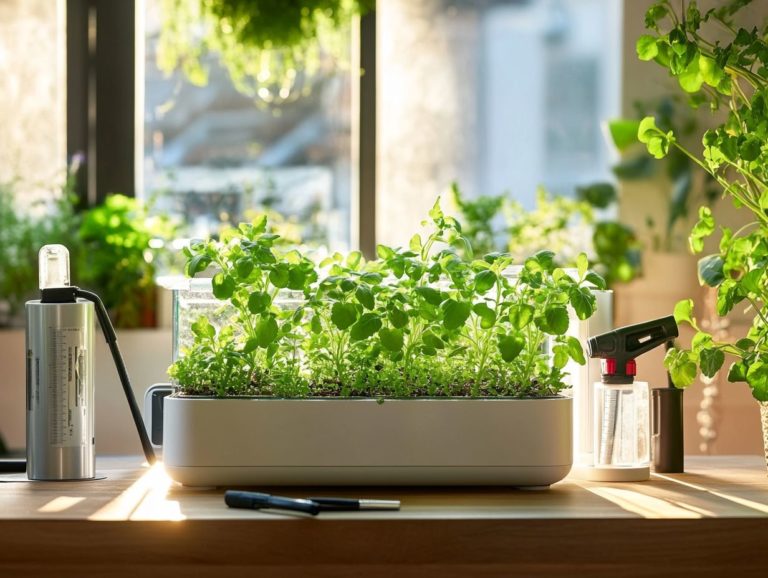How to Handle Hydroponic System Calibration
In the realm of hydroponics, precision is paramount for nurturing healthy, thriving plants. Ensuring that your hydroponic system is properly calibrated means fine-tuning nutrient levels, pH, and water temperature to perfection.
This guide delves into the essentials of hydroponic system calibration, highlighting its significance, the potential pitfalls of incorrect settings, and providing you with step-by-step instructions for calibration. It also tackles common troubleshooting issues and offers maintenance tips to ensure your system operates at peak performance. Dive in and cultivate your green thumb with unwavering confidence!
Contents
Key Takeaways:

- Proper calibration is crucial for the success of your hydroponic system, as it ensures accurate nutrient delivery to your plants.
- Incorrect calibration can lead to stunted growth, nutrient deficiencies, and other issues that negatively impact your plants.
- The key steps for calibration include gathering the necessary materials, following the specific process for your system, and troubleshooting any issues that may arise.
Understanding Hydroponic System Calibration
Understanding hydroponic system calibration is essential for achieving success in crop production within hydroponics. Consistent pH levels and a balanced nutrient mix directly influence plant health and optimal growth.
Calibration guarantees that the pH of your nutrient solution meets the specific needs of various crops, from fruits and vegetables to beans and melons. This practice helps you avoid nutrient deficiencies, so your plants can thrive and maximize your yield.
By diligently monitoring and adjusting pH levels, you enhance nutrient availability, creating an ideal environment for robust plant development.
What is Hydroponic System Calibration?
Hydroponic system calibration is ensuring that the pH levels of your nutrient solution are meticulously measured and adjusted for optimal plant growth. This careful process requires you to conduct regular pH testing to maintain an ideal range that promotes maximum nutrient availability.
Consider advanced systems like deep water culture or nutrient film technique setups, which highlight the critical importance of precise calibration. Even minor fluctuations can significantly impact plant health. For example, if your pH dips below 5.5, you risk hindering essential nutrient absorption; conversely, levels above 6.5 can lock out vital nutrients, leading to deficiencies. To address any issues you encounter, refer to this guide on how to troubleshoot common hydroponic issues.
To achieve this delicate balance, you can utilize pH adjusters like phosphoric or nitric acid, which enable you to fine-tune your solution. Consistent calibration enhances the efficiency of various nutrient solutions, allowing you to harvest healthier, more robust plants, ultimately boosting yield and reducing waste.
Why is Calibration Important?
Calibration is crucial in hydroponics, as it directly impacts the pH balance. This balance is vital for ensuring nutrient availability, which supports the optimal growth of your plants in a carefully controlled environment.
Potential Effects of Incorrect Calibration

Incorrect calibration in hydroponic systems can seriously affect plant health, often manifesting as nutrient deficiencies due to improper pH levels and an imbalance in acidity or alkalinity. When nutrient solutions aren t calibrated accurately, a myriad of issues can arise, including sluggish growth rates and significant losses in crop yield.
For example, if nitrogen levels fall short, leafy greens like lettuce may show stunted growth, while tomatoes could suffer from blossom-end rot, primarily due to a lack of calcium. These imbalances can trigger specific deficiencies in essential nutrients, ultimately compromising overall plant vigor and resilience.
As a result, you might find that your crops are not only struggling to thrive but are also more vulnerable to diseases and pests, exacerbating the challenges of maintaining a healthy hydroponic environment.
Start calibrating your system today to grow thriving plants!
Steps for Calibrating Your Hydroponic System
Calibrating your hydroponic system requires a careful method, involving a series of straightforward steps designed to ensure that your nutrient solution maintains the precise pH levels essential for optimal plant growth.
This process necessitates the use of pH testing kits and the discipline of regular monitoring to achieve the best results.
Gathering Necessary Materials
To successfully calibrate your hydroponic system, you’ll need specific materials. This includes pH testing kits and adjusters like pH up or pH down.
Having a clean container for mixing solutions can significantly enhance your accuracy. Typically, pH testing kits come with strips or meters that provide immediate readings, allowing you to make quick adjustments as needed.
It s wise to use distilled or deionized water for calibration, as impurities in tap water can throw off your results. Household items like vinegar or baking soda can work wonders as natural pH adjusters, offering an effective way to tweak acidity.
By carefully measuring these components, you’re setting the stage for a balanced environment that’s perfect for plant growth.
Calibration Process for Different Systems
The calibration process for hydroponic systems can vary significantly, but it typically involves regular pH testing and adjustments to ensure that the nutrient solution meets the needs of various plant varieties.
For example, if you’re working with deep water culture, you ll find that it requires a slightly different approach compared to nutrient film technique and aeroponics.
In deep water culture, maintaining a pH range of 5.5 to 6.5 is essential for optimal plant growth. In contrast, nutrient film technique may require more frequent pH checks due to its recirculating nature, often gravitating towards a pH level around 6.0.
Aeroponics, however, demands even more precise calibrations; the nutrient mist applied directly to the roots thrives at a pH of about 5.5.
Recognizing the unique requirements of each system is crucial. You ll need to understand how different plants react to variations in nutrient solutions and pH levels, as these factors ultimately influence their growth and yield.
Troubleshooting Calibration Issues

Troubleshooting calibration issues in hydroponic systems is essential for maintaining optimal pH levels and fostering healthy plant growth.
By mastering this process, you can swiftly identify and address common problems, ensuring your plants thrive under your care.
Common Problems and Solutions
You may encounter common challenges in hydroponic calibration, such as unstable pH levels, nutrient deficiencies, and improper use of pH adjusters.
If left unaddressed, these issues can significantly hinder plant growth. When the pH strays from the optimal range, it can result in nutrient lockout when plants can’t take in the nutrients they need preventing your plants from absorbing essential elements.
This often leads to stunted growth and disappointing crop yields. Such instability can arise from environmental factors or poorly calibrated monitoring equipment, causing you to overlook crucial adjustments.
Using the wrong pH adjusters can make matters worse, leading to further fluctuations and added stress for your plants.
To tackle these challenges effectively, it’s essential to regularly test water quality and nutrient levels, along with utilizing high-quality calibration solutions. For more detailed guidance, you can refer to how to maintain your hydroponic growing system. Establishing a routine maintenance schedule will help you create a stable growing environment, ultimately fostering healthy, thriving plants.
Maintaining Proper Calibration
Maintaining proper calibration in your hydroponic system is an ongoing endeavor that demands your attention. Regularly monitoring pH balance and making timely adjustments are essential to ensure that the nutrient solution effectively supports optimal plant health.
Follow this process closely, and watch your plants thrive in a meticulously balanced environment!
How Often to Recalibrate and Tips for Maintenance
Regularly recalibrating your hydroponic system is essential. Aim to do it every few weeks to maintain consistent pH levels and ensure your nutrient solution supports optimal plant growth.
Many factors can affect pH levels. Temperature changes, nutrient composition, and the specific needs of your plants all play a role.
Keep a close eye on your plants for signs that recalibration is needed. Yellowing leaves or stunted growth may indicate that pH adjustments are necessary.
Investing in a reliable pH meter can help you maintain ideal conditions. Conduct checks after significant environmental changes or adjustments to your nutrient mix.
Frequently Asked Questions

What is hydroponic system calibration?
Hydroponic system calibration is the process of adjusting and fine-tuning various components of a hydroponic system to ensure optimal plant growth and nutrient delivery.
Why is hydroponic system calibration important?
Proper calibration ensures that plants receive the correct balance of nutrients, water, and oxygen, which is crucial for their growth and health in a hydroponic system.
How often should I calibrate my hydroponic system?
It is recommended to calibrate your hydroponic system at least once a week to maintain proper nutrient levels and prevent any imbalances that could harm your plants.
What are the components of a hydroponic system that require calibration?
The key components that require calibration in a hydroponic system include pH levels, nutrient solution strength, water flow and pump settings, and light intensity.
How do I calibrate the pH levels in my hydroponic system?
To calibrate the pH levels, you will need a pH testing kit and pH adjusters. Start by testing the pH levels of your nutrient solution and adjusting it to the desired range using the pH adjusters.
Do I need any special tools or equipment to calibrate my hydroponic system?
Yes, you will need a few basic tools such as a pH testing kit, pH adjusters, measuring cups, and a TDS meter (Total Dissolved Solids meter), which measures the concentration of nutrients in the water.
Start recalibrating your system today! Watch the video above for more tips on maintaining a healthy hydroponic environment.






